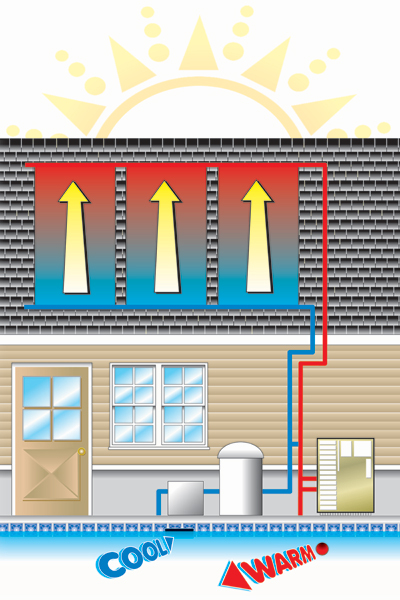Types of Solar Thermal Collectors
Solar thermal is a technology for harnessing solar energy for thermal energy, which can then be used for heating or cooling purposes. Solar thermal collectors are classified as low-, medium-, or high-temperature collectors.
Low-temperature Collectors
Constructed of durable, yet cost-effective polymers, this type of collector can heat water to temperatures of approximately 100 degrees Fahrenheit (38 C), and are most often used to heat swimming pools. Since these collectors are not insulated from the elements with a solar glass like medium- or high-temperature collectors, they are referred to as “unglazed” collectors.
Medium-temperature Collectors
Insulated (glazed) from the elements, this type of collector is generally constructed of aluminum and glass with a copper absorber plate. This type of collector is used for heating water or air for residential and commercial use. Medium-temperature collectors are also used, in some cases, in commercial pool heating applications. However, they are still widely considered cost-prohibitive for residential pool heating applications.
High-temperature Collectors
Capable of heating water to temperatures well above that which is required to create steam, these collectors are often used in industrial process preheating applications. There are also collectors of this type used to concentrate sunlight using mirrors or lenses and are generally used for electric power production.
How Solar Pool Heating Works
Simple, Dependable, and Affordable
Solar pool heaters operate on a very simple concept: using the existing pump and filtration, pool water is diverted to the solar collectors where it is warmed by the sun before returning to the pool. Though systems can be installed to operate manually, the majority are installed in conjunction with an automatic controller. The controller, which is wired to two sensors which compare the pool’s temperature to available solar energy, then signals a motorized valve to turn the system on or off.
Installation is simple, and takes an average-sized crew about one day to complete. Collectors are generally installed on the roof, but can be placed anywhere that receives constant sunlight. Systems are mounted using heavy-duty stainless steel mounting hardware and our polypropylene-coated stainless steel strap.
A properly-sized and installed solar heating system will raise an unheated pool’s temperature 10-15 degrees Fahrenheit, extending (and often doubling) the length of the swim season.
Though the average cost of an installed system is comparable to that of a conventional gas heater, we can guarantee your customer will never get a utility bill from the sun. Once installed, a solar pool heating system will provide years of free heat, and can often pay for itself in as little as 3 years.
Evolution of Solar Collector Design
1970s – Square Tube-on-Tube
- Earliest effort at polymer solar pool heating system.
- Tube separations due to expansion & contraction.
- Thicker tube-walls result in low efficiency.
1980s – Round Tube-on-Tube
- Round tubes & thinner walls meant higher efficiency.
- Buckling & weakening due to expansion & contraction.
1990s – Loose Tube
- Separate tubes eliminate stress from expansion & contraction.
- Spaces trap leaves and debris between collectors & roof,
- also results in decreased performance from wind.
Today – Tube-and-Web
- Designed to handle extreme expansion & contraction while providing maximum solar collector surface area.
- Vents are often incorporated to combine wind-load relief benefits of loose tube collector with the surface area of a full plate.




